HONDA CR-Z 2013 1.G Owners Manual
Manufacturer: HONDA, Model Year: 2013, Model line: CR-Z, Model: HONDA CR-Z 2013 1.GPages: 325, PDF Size: 11.73 MB
Page 281 of 325
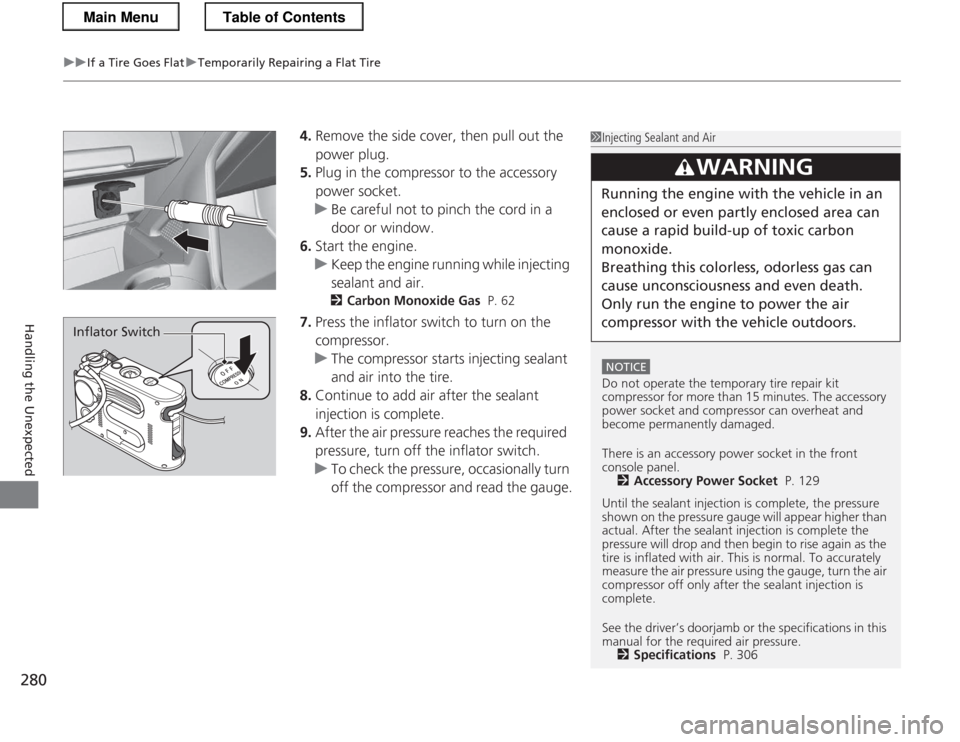
uuIf a Tire Goes FlatuTemporarily Repairing a Flat Tire
280
Handling the Unexpected
4. Remove the side cover, then pull out the
power plug.
5. Plug in the compressor to the accessory
power socket.
uBe careful not to pinch the cord in a
door or window.
6. Start the engine.
uKeep the engine running while injecting sealant and air.
2 Carbon Monoxide Gas P. 62
7. Press the inflator switch to turn on the compressor.
uThe compressor starts injecting sealant and air into the tire.
8. Continue to add air after the sealant
injection is complete.
9. After the air pressure reaches the required
pressure, turn off the inflator switch.
uTo check the pressure, occasionally turn
off the compressor and read the gauge.
1Injecting Sealant and Air
NOTICE
Do not operate the temporary tire repair kit
compressor for more than 15 minutes. The accessory
power socket and compressor can overheat and become permanently damaged.
There is an accessory power socket in the front
console panel.
2 Accessory Power Socket P. 129
Until the sealant injectio n is complete, the pressure
shown on the pressure gauge will appear higher than
actual. After the sealan t injection is complete the
pressure will drop and then begin to rise again as the
tire is inflated with air. Th is is normal. To accurately
measure the air pressure using the gauge, turn the air
compressor off only after the sealant injection is complete.
See the driver’s doorjamb or the specifications in this
manual for the required air pressure. 2 Specifications P. 306
3WARNING
Running the engine with the vehicle in an
enclosed or even partly enclosed area can
cause a rapid build-up of toxic carbon
monoxide.
Breathing this colorless, odorless gas can
cause unconsciousness and even death. Only run the engi ne to power the air
compressor with the vehicle outdoors.
Inflator Switch
Main MenuTable of Contents
Page 282 of 325
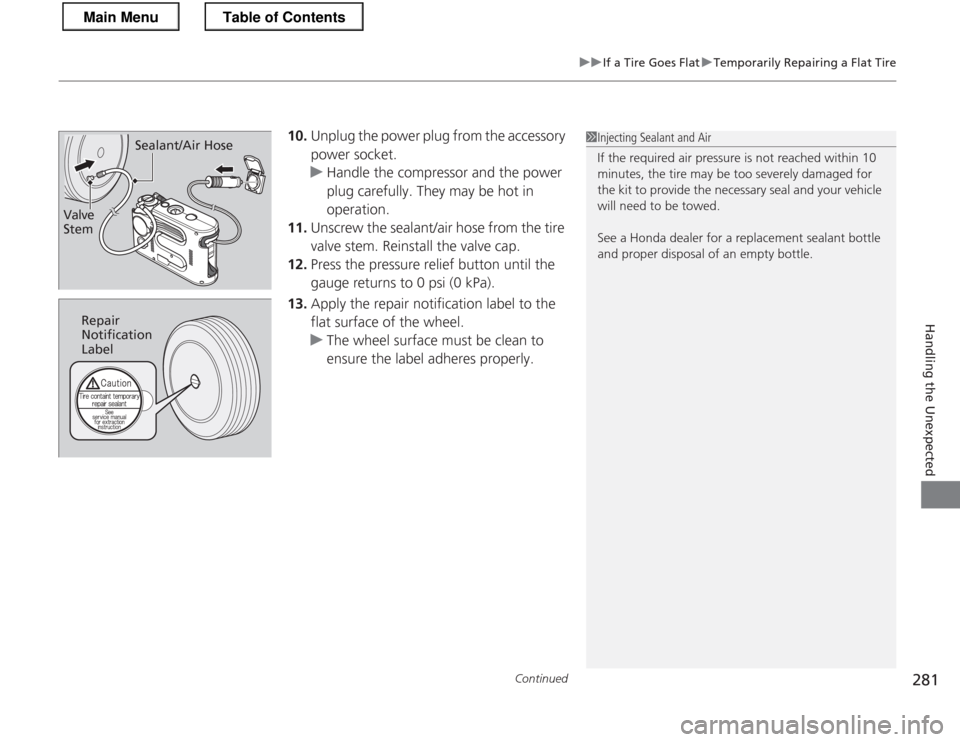
Continued281
uuIf a Tire Goes FlatuTemporarily Repairing a Flat Tire
Handling the Unexpected
10.Unplug the power plug from the accessory power socket.
uHandle the compressor and the power
plug carefully. They may be hot in operation.
11. Unscrew the sealant/air hose from the tire
valve stem. Reinstall the valve cap.
12. Press the pressure relief button until the
gauge returns to 0 psi (0 kPa).
13. Apply the repair notification label to the
flat surface of the wheel.
uThe wheel surface must be clean to
ensure the label adheres properly.
1Injecting Sealant and Air
If the required air pressure is not reached within 10
minutes, the tire may be too severely damaged for
the kit to provide the necessary seal and your vehicle will need to be towed.
See a Honda dealer for a re placement sealant bottle
and proper disposal of an empty bottle.Sealant/Air Hose
Valve Stem
Repair
Notification Label
Main MenuTable of Contents
Page 283 of 325
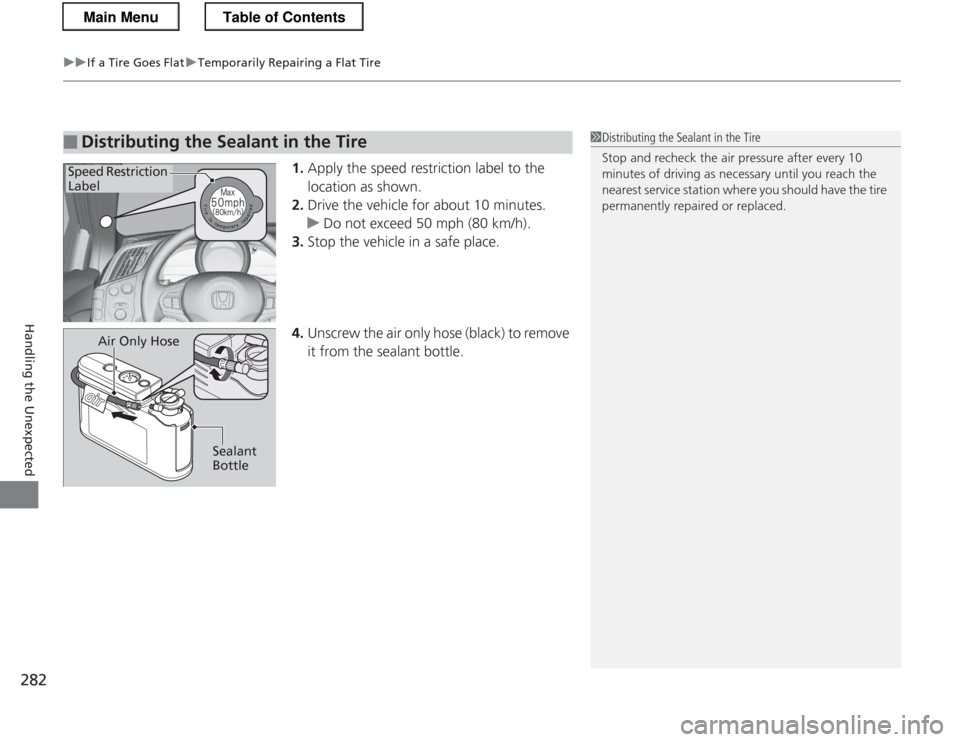
uuIf a Tire Goes FlatuTemporarily Repairing a Flat Tire
282
Handling the Unexpected
1. Apply the speed restriction label to the
location as shown.
2. Drive the vehicle for about 10 minutes.
uDo not exceed 50 mph (80 km/h).
3. Stop the vehicle in a safe place.
4. Unscrew the air only hose (black) to remove
it from the sealant bottle.
■Distributing the Sealant in the Tire1Distributing the Sealant in the Tire
Stop and recheck the air pressure after every 10
minutes of driving as necessary until you reach the
nearest service station where you should have the tire
permanently repaired or replaced.
Speed Restriction Label
Air Only Hose
Sealant Bottle
Main MenuTable of Contents
Page 284 of 325
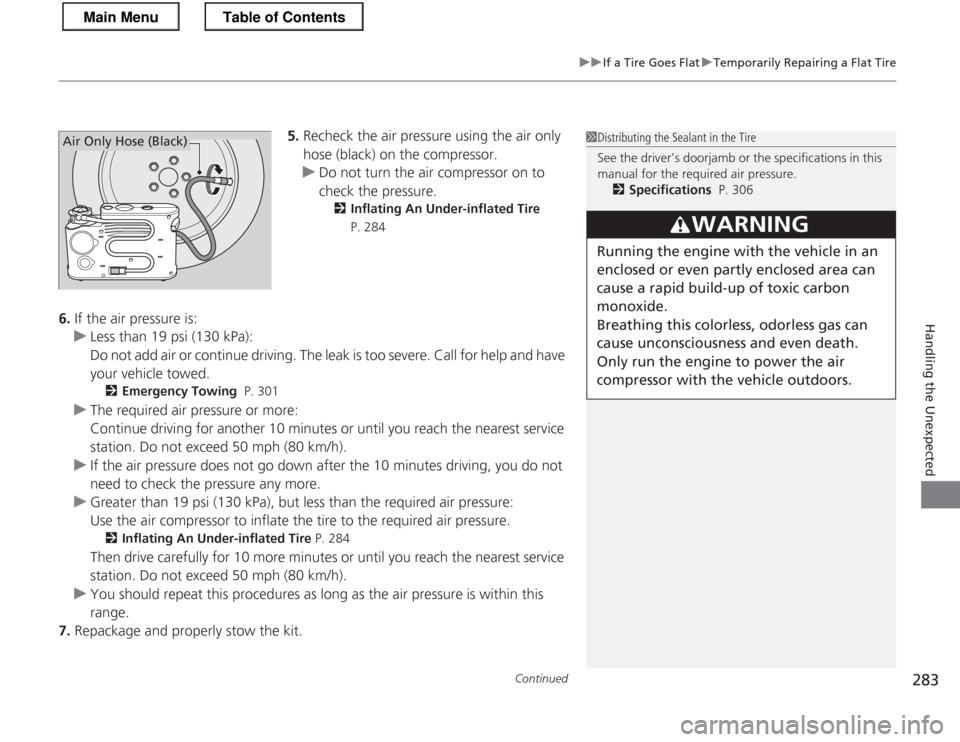
Continued283
uuIf a Tire Goes FlatuTemporarily Repairing a Flat Tire
Handling the Unexpected
5.Recheck the air pressure using the air only
hose (black) on the compressor.
uDo not turn the air compressor on to
check the pressure.
2 Inflating An Under-inflated Tire
P. 284
6. If the air pressure is:
uLess than 19 psi (130 kPa):
Do not add air or continue driving. The leak is too severe. Call for help and have
your vehicle towed.
2 Emergency Towing P. 301
uThe required air pressure or more:
Continue driving for another 10 minutes or until you reach the nearest service
station. Do not exceed 50 mph (80 km/h).
uIf the air pressure does not go down after the 10 minutes driving, you do not
need to check the pressure any more.
uGreater than 19 psi (130 kPa), but less than the required air pressure:
Use the air compressor to inflate the tire to the required air pressure.
2 Inflating An Under-inflated Tire P. 284
Then drive carefully for 10 more minutes or until you reach the nearest service
station. Do not exceed 50 mph (80 km/h).
uYou should repeat this procedures as long as the air pressure is within this range.
7. Repackage and properly stow the kit.
1Distributing the Sealant in the Tire
See the driver’s doorjamb or the specifications in this
manual for the required air pressure.
2 Specifications P. 306
3WARNING
Running the engine with the vehicle in an
enclosed or even partly enclosed area can
cause a rapid build-up of toxic carbon
monoxide.
Breathing this colorless, odorless gas can
cause unconsciousness and even death. Only run the engi ne to power the air
compressor with the vehicle outdoors.
Air Only Hose (Black)
Main MenuTable of Contents
Page 285 of 325
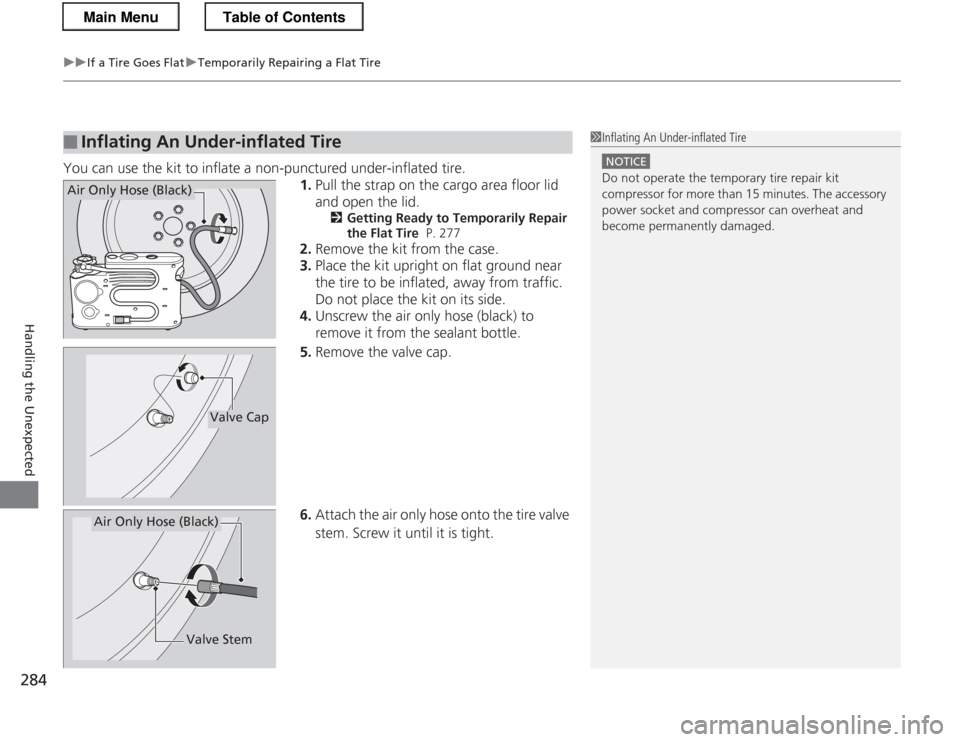
uuIf a Tire Goes FlatuTemporarily Repairing a Flat Tire
284
Handling the Unexpected
You can use the kit to inflate a non-punctured under-inflated tire. 1.Pull the strap on the cargo area floor lid
and open the lid.
2 Getting Ready to Temporarily Repair
the Flat Tire P. 277
2. Remove the kit from the case.
3. Place the kit upright on flat ground near
the tire to be inflated, away from traffic.
Do not place the kit on its side.
4. Unscrew the air only hose (black) to
remove it from the sealant bottle.
5. Remove the valve cap.
6. Attach the air only hose onto the tire valve
stem. Screw it until it is tight.
■Inflating An Under-inflated Tire1Inflating An Under-inflated Tire
NOTICE
Do not operate the temporary tire repair kit
compressor for more than 15 minutes. The accessory
power socket and compressor can overheat and become permanently damaged.
Air Only Hose (Black)
Valve Cap
Air Only Hose (Black)
Valve Stem
Main MenuTable of Contents
Page 286 of 325
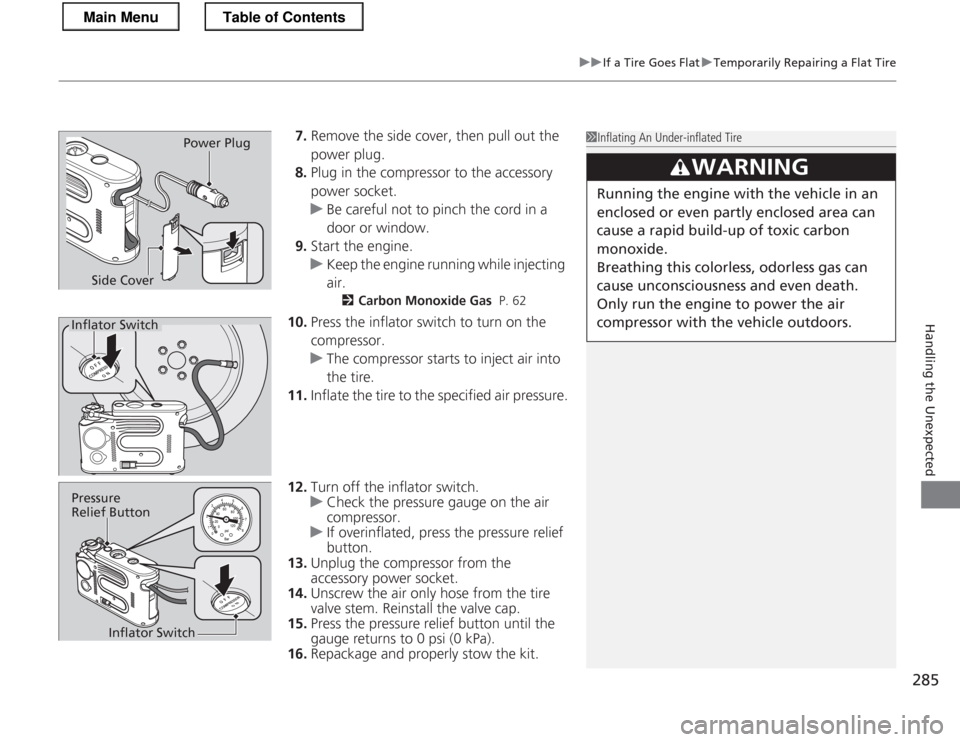
285
uuIf a Tire Goes FlatuTemporarily Repairing a Flat Tire
Handling the Unexpected
7.Remove the side cover, then pull out the
power plug.
8. Plug in the compressor to the accessory power socket.
uBe careful not to pinch the cord in a
door or window.
9. Start the engine.
uKeep the engine running while injecting air.
2 Carbon Monoxide Gas P. 62
10. Press the inflator switch to turn on the compressor.
uThe compressor starts to inject air into
the tire.
11. Inflate the tire to the specified air pressure.
12. Turn off the inflator switch.
uCheck the pressure gauge on the air
compressor.
uIf overinflated, press the pressure relief button.
13. Unplug the compressor from the
accessory power socket.
14. Unscrew the air only hose from the tire
valve stem. Reinstall the valve cap.
15. Press the pressure relief button until the
gauge returns to 0 psi (0 kPa).
16. Repackage and properly stow the kit.
1Inflating An Under-inflated Tire
3WARNING
Running the engine with the vehicle in an
enclosed or even partly enclosed area can
cause a rapid build-up of toxic carbon
monoxide.
Breathing this colorless, odorless gas can
cause unconsciousness and even death. Only run the engi ne to power the air
compressor with the vehicle outdoors.
Side Cover Power Plug
Inflator Switch
Inflator Switch
Pressure
Relief Button
Main MenuTable of Contents
Page 287 of 325
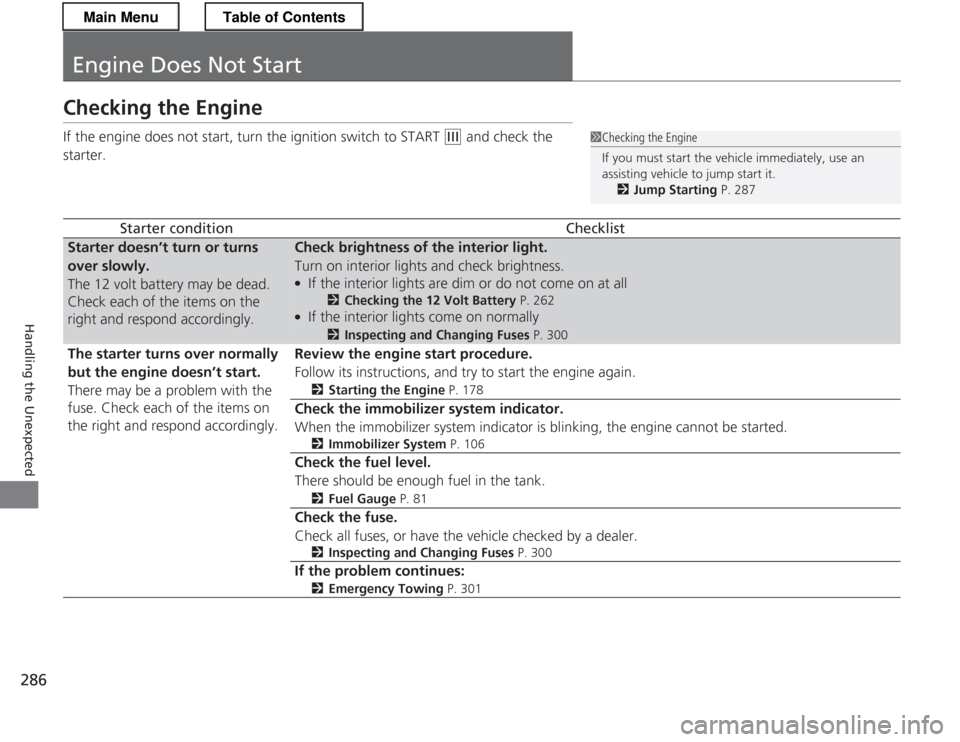
286
Handling the Unexpected
Engine Does Not Start
Checking the Engine
If the engine does not start, turn the ignition switch to START
(e and check the
starter.
Starter conditionChecklist
Starter doesn’t turn or turns over slowly.
The 12 volt battery may be dead.
Check each of the items on the
right and respond accordingly.Check brightness of the interior light.
Turn on interior lights and check brightness. ● If the interior lights are dim or do not come on at all
2Checking the 12 Volt Battery P. 262
● If the interior lights come on normally 2
Inspecting and Changing Fuses P. 300
The starter turns over normally
but the engine doesn’t start.
There may be a problem with the
fuse. Check each of the items on
the right and respond accordingly.Review the engine start procedure.
Follow its instructions, and try to start the engine again. 2Starting the Engine P. 178
Check the immobilizer system indicator.
When the immobilizer system indicator is blinking, the engine cannot be started.
2Immobilizer System P. 106
Check the fuel level. There should be enough fuel in the tank. 2Fuel Gauge P. 81
Check the fuse.
Check all fuses, or have the vehicle checked by a dealer.
2Inspecting and Changing Fuses P. 300
If the problem continues:
2 Emergency Towing P. 301
1Checking the Engine
If you must start the vehicle immediately, use an assisting vehicle to jump start it.
2 Jump Starting P. 287
Main MenuTable of Contents
Page 288 of 325
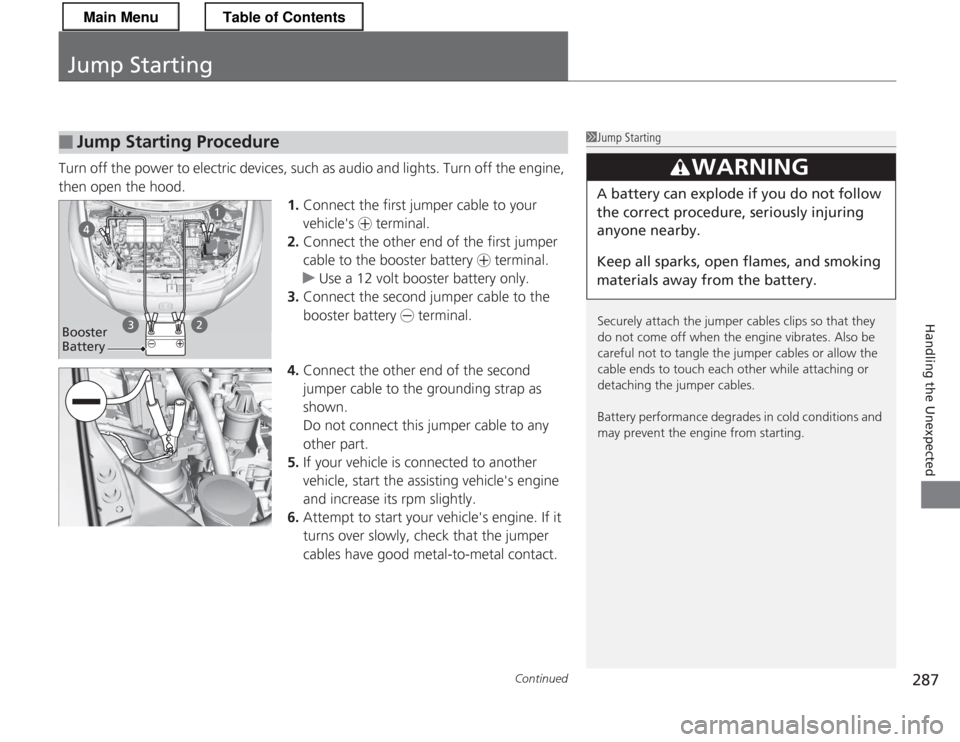
287
Continued
Handling the Unexpected
Jump Starting
Turn off the power to electric devices, such as audio and lights. Turn off the engine,
then open the hood.
1.Connect the first jumper cable to your
vehicle's + terminal.
2. Connect the other end of the first jumper
cable to the booster battery + terminal.
uUse a 12 volt booster battery only.
3. Connect the second jumper cable to the booster battery - terminal.
4. Connect the other end of the second
jumper cable to the grounding strap as
shown.
Do not connect this jumper cable to any other part.
5. If your vehicle is co nnected to another
vehicle, start the assisting vehicle's engine
and increase its rpm slightly.
6. Attempt to start your vehicle's engine. If it
turns over slowly, check that the jumper cables have good metal-to-metal contact.
■Jump Starting Procedure1Jump Starting
Securely attach the jumper cables clips so that they
do not come off when the engine vibrates. Also be
careful not to tangle the jumper cables or allow the
cable ends to touch each other while attaching or
detaching the jumper cables.
Battery performance degrades in cold conditions and
may prevent the engine from starting.
3WARNING
A battery can explode if you do not follow the correct procedure, seriously injuring anyone nearby.
Keep all sparks, open flames, and smoking
materials away from the battery.
Booster
Battery
Main MenuTable of Contents
Page 289 of 325
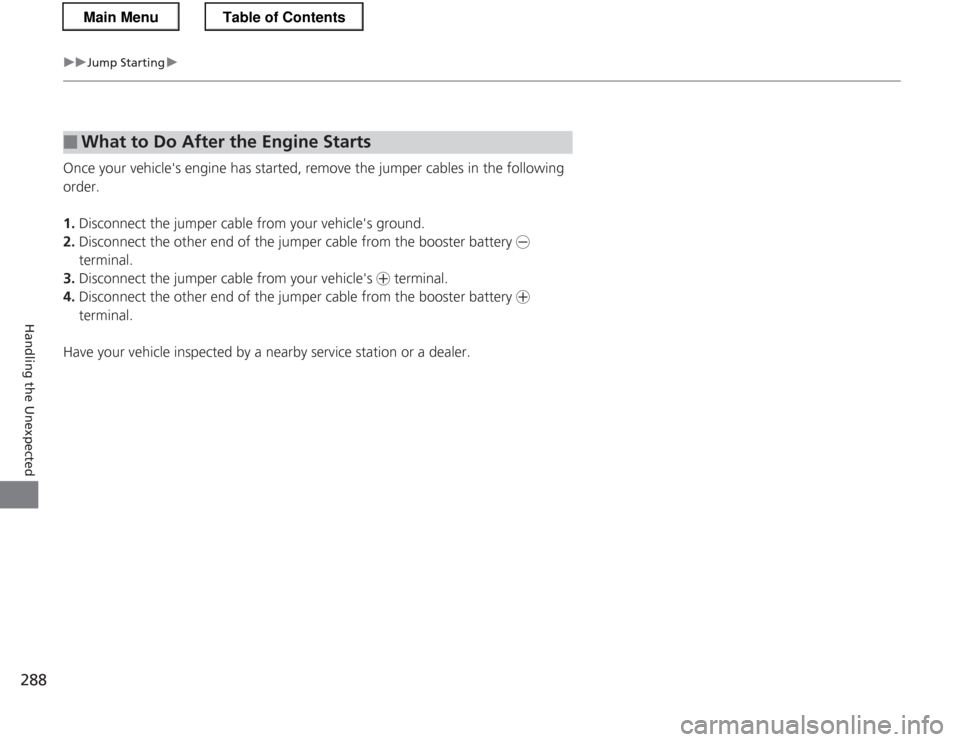
288
uuJump Startingu
Handling the Unexpected
Once your vehicle's engine has started, remove the jumper cables in the following order. 1.Disconnect the jumper cable from your vehicle's ground.
2. Disconnect the other end of the ju mper cable from the booster battery -
terminal.
3. Disconnect the jumper cable from your vehicle's + terminal.
4. Disconnect the other end of the ju mper cable from the booster battery +
terminal.
Have your vehicle inspected by a nearby service station or a dealer.
■What to Do After the Engine Starts
Main MenuTable of Contents
Page 290 of 325
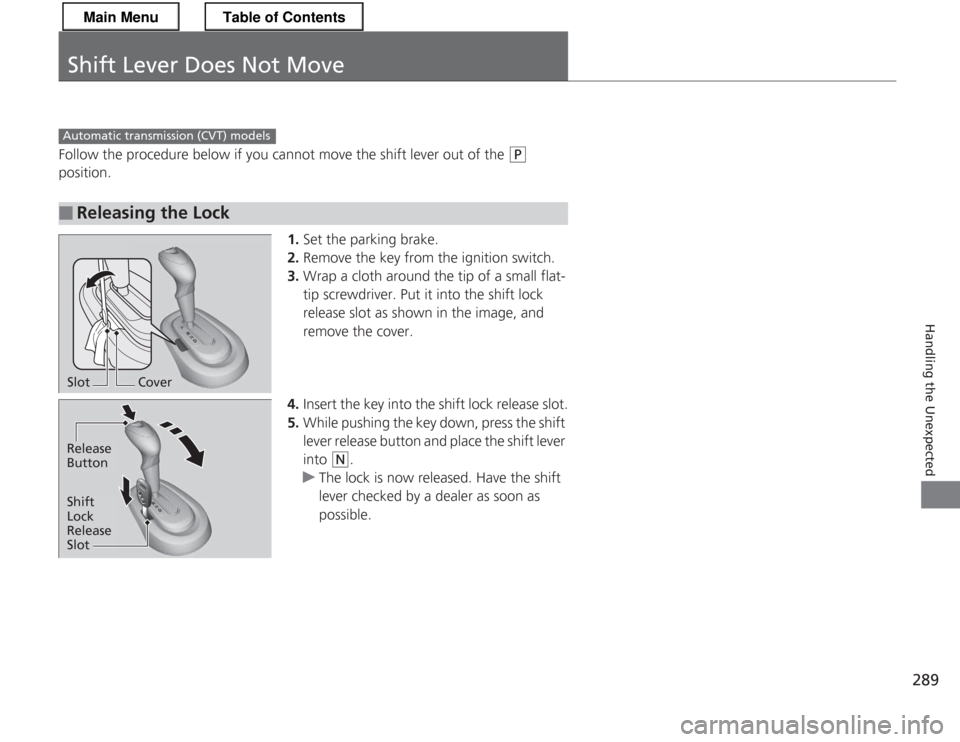
289
Handling the Unexpected
Shift Lever Does Not Move
Follow the procedure below if you cannot move the shift lever out of the (P
position.
1.Set the parking brake.
2. Remove the key from the ignition switch.
3. Wrap a cloth around the tip of a small flat-
tip screwdriver. Put it into the shift lock
release slot as shown in the image, and remove the cover.
4. Insert the key into the shift lock release slot.
5. While pushing the key down, press the shift
lever release button and place the shift lever
into
(N .
uThe lock is now released. Have the shift
lever checked by a dealer as soon as
possible.
■Releasing the Lock
Automatic transmiss ion (CVT) models
SlotCover
Release Button
Shift
Lock Release
Slot
Main MenuTable of Contents